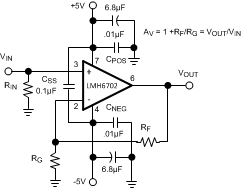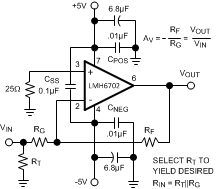JAJSUH5F July 2005 – August 2024 LMH6702QML-SP
PRODUCTION DATA
6.1.1 Feedback Resistor
 Figure 6-1 Recommended Noninverting Gain
Circuit
Figure 6-1 Recommended Noninverting Gain
Circuit Figure 6-2 Recommended Inverting Gain
Circuit
Figure 6-2 Recommended Inverting Gain
CircuitThe LMH6702 achieves excellent pulse and distortion performance by using current feedback topology. The loop gain for a current-feedback op amp, and thus the frequency response, is predominantly set by the feedback-resistor value. The LMH6702 is optimized for use with a 237Ω feedback resistor. Using lower values can lead to excessive ringing in the pulse response while a higher value limits the bandwidth. Application Note OA-13 SNOA366 discusses this configuration in detail along with the occasions where a different RF can be advantageous.